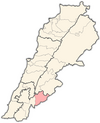Rachaya Al Foukhar
Rachaya Al Foukhar
راشيا الفخار | |
|---|---|
City | |
![Rachaya Al Foukhar, in the 1880s:[1]](https://upload.wikimedia.org/wikipedia/commons/thumb/a/a2/Rachaya_al-Foukhara.jpg/250px-Rachaya_al-Foukhara.jpg) Rachaya Al Foukhar, in the 1880s:[1] | |
| Coordinates:33°21′12″N35°40′02″E/ 33.35333°N 35.66722°E | |
| Grid position | 148/157 L |
| Country | |
| Governorate | Nabatieh Governorate |
| District | Hasbaya District |
| Time zone | UTC+2(EET) |
| • Summer (DST) | UTC+3(EEST) |
| Dialing code | +961 |
Rachaya Al Foukhar(also spelledRashaya Al Foukhar,Arabic:راشيا الفخار) is aLebanesevillage in the district ofHasbayain theNabatiye Governoratein southernLebanon.It is located on the western slopes ofMount Hermonat an altitude starting at 750 m with the highest summit being at 1,250 m. The population isGreek Orthodox.
History
[edit]In 1838, during theOttomanera,Eli Smithnoted the population of Rachaya Al Foukhar as being"Greek" Christians.[2]
In 1852Edward Robinsonnoted: "The village is celebrated for its pottery; for the manufacture of which it is one of the chief seats. There are many large dome-shaped furnaces for burning of ware; and many specimens were standing outside of the houses [..], tall jars, and the like. This pottery is sent around to all the fairs of the country, and far into theHauran;as also toHumsandHamah."[3]
In 1875,Victor Guérinfound here a town with 700 inhabitants, mostly "Schismatic Greek".He also noted the pottery production, and that there was a smallProtestantmission in the place.[4]
In 1990, U.S missionary William Robinson was killed here by masked gunmen.[5]
Demographics
[edit]In 2014Christiansmade up 97,81% of registered voters in Rachaya Al Foukhar. 49.31% of the voters wereGreek Orthodox,24,95% wereGreek Catholicsand 12,66% wereMaronite Catholics.[6]
References
[edit]- ^Wilson, ca 1881, vol 2, p125:"This place, as the name implies, is famous for its potters´s clay. Its furnaces are dome-shaped and capable of burning enormous jars. The potter; mounted on a high seat, sets the wheel in motion with his foot and shapes the clay with his hand. The man beyond is adding handles to the jars."
- ^Robinson and Smith, 1841, vol 3, 2nd appendix, p.138
- ^Robinson and Smith, 1856, pp.415-416
- ^Guérin, 1880, pp.284-5
- ^U.S. Missionary Shot to Death At Home in South Lebanon,Ihsan A. Hijazi, March 29, 1990,The New York Times
- ^https://lub-anan /المحافظات/النبطية/حاصبيا/راشيا-الفخار/المذاهب/
Bibliography
[edit]- Guérin, V.(1880).Description Géographique Historique et Archéologique de la Palestine(in French). Vol. 3: Galilee, pt. 2. Paris: L'Imprimerie Nationale.
- Robinson, E.;Smith, E.(1841).Biblical Researches in Palestine, Mount Sinai and Arabia Petraea: A Journal of Travels in the year 1838.Vol. 3. Boston:Crocker & Brewster.
- Robinson, E.;Smith, E.(1856).Later Biblical Researches in Palestine and adjacent regions: A Journal of Travels in the year 1852.London:John Murray.
- Wilson, C.W.,ed. (c. 1881).Picturesque Palestine, Sinai and Egypt.Vol. 2. New York:D. Appleton.
External links
[edit]- Rachaiya El Foukhar,Localiban


